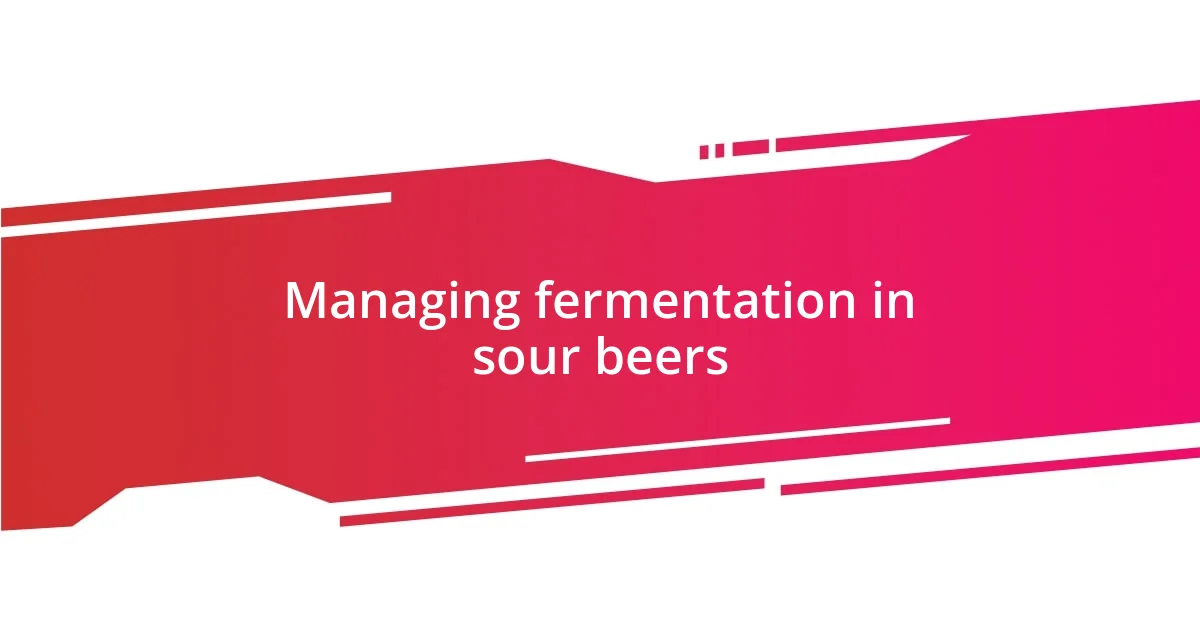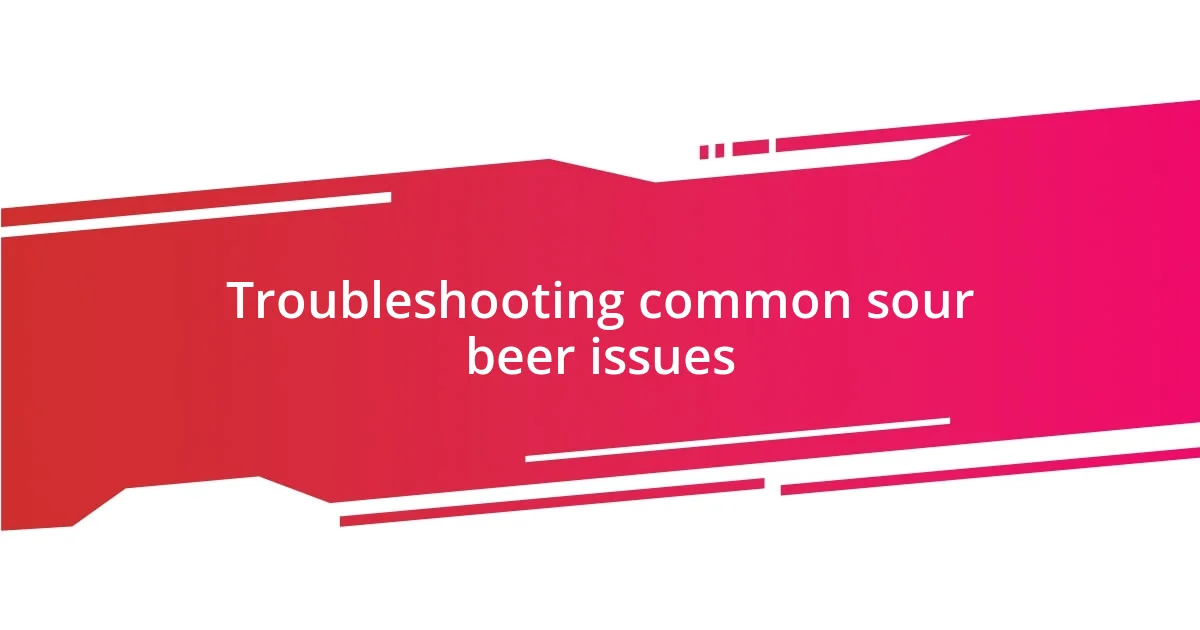Key takeaways:
- Sour beers primarily fall into wild ales and lambics, with unique flavors influenced by fermentation, yeast, and environmental factors.
- Key ingredients for sour brewing include specific yeast/bacteria, a well-balanced grain bill, and selective hop additions, each contributing significantly to the flavor profile.
- Techniques like kettle souring, barrel aging, and careful fermentation management enhance the complexity of sour beers, while proper sanitation and patience are vital to prevent common issues.

Understanding sour beer styles
When diving into sour beer styles, it’s essential to recognize that they primarily fall under two categories: wild ales and lambics. I remember the first time I tried a lambic; the complex flavors burst on my palate, leaving me both confused and intrigued. Have you ever tasted something that made you question everything you thought you knew about beer?
Wild ales are fascinating because they embrace the unpredictability of fermentation. I once experimented with a wild ale at home, letting nature take its course. The results were surprising, with each batch telling a unique story shaped by the yeast and bacteria involved. Isn’t it remarkable how much the environment can influence the final product?
On the other hand, the refreshing tartness of Berliner Weisse or the funky character of Gose introduces a delightful contrast to traditional beers. My journey with these styles has taught me to appreciate the nuances of sourness and how they can complement fruit flavors. What’s your experience with these styles? It’s incredible how they can transform an ordinary tasting session into a vibrant exploration of flavors.

Essential ingredients for sour beer
Sour beers derive their distinctive flavors from a selective blend of ingredients, each playing a critical role in the brewing process. One of the most essential components is the type of yeast and bacteria used for fermentation. My initial foray into brewing sour beer was met with hesitation; I wondered if I could really embrace the wild behavior of Brettanomyces strains. The first time I smelled a batch flavored with Brett, it was as if I had unleashed an entire new world of aroma. It’s a leap, but worth every daring step.
Another crucial ingredient is the grain bill. In my experience, using a mix of pale malt and specialty grains can set the perfect foundation for brewing. I remember my first attempt where I added a touch of Munich malt for depth, and it created this incredible backbone that perfectly balanced the sourness. It was a pleasant surprise that those small adjustments could lead to such complex flavors—truly an eye-opening moment!
Hops, while they play a lesser role in sour beers compared to their more traditional counterparts, still add a delightful twist. When I brewed my first Flanders Red Ale, I opted for minimal hopping but carefully selected a late addition to introduce a hint of floral notes. That delicate touch opened up a new dimension of flavor, reminding me how every little detail in the brewing process contributes to the overall experience. Have you experimented with hops in your sour brews? You might find that that subtlety creates angles of flavor you never anticipated.
| Ingredient | Description |
|---|---|
| Yeast/Bacteria | Wild strains like Brettanomyces and Lactobacillus contribute to the sour profile and complexity. |
| Grain Bill | A blend of malts enhances the body and the flavor base which complements sour notes. |
| Hops | Used sparingly; they can add depth without overpowering the sourness. |

Brewing techniques for sour flavors
Brewing sour beers requires a deep understanding of various techniques that can elevate the sourness to new heights. One approach I’ve found particularly effective is the process of kettle souring. I remember the first time I tried it; I was amazed at how simple it was yet resulted in a beautifully tart Berliner Weisse. By introducing Lactobacillus into the wort before boiling, I was able to achieve a clean sourness that set the stage for some amazing flavor combinations later on. It felt like unlocking a hidden level in brewing, where I had control over the sourness right from the start.
There are several key techniques to consider when brewing for sour flavors:
- Kettle Souring: Introduces sourness early in the process by using Lactobacillus before boiling.
- Barrel Aging: Provides depth and complexity as wild yeast and bacteria develop flavors over time.
- Mixed Fermentation: Combines various yeast and bacteria strains, resulting in unique and unpredictable profiles.
- Ph Adjustments: Monitoring pH can help achieve the desired tartness; lower pH generally equals more sourness.
- Fruit Additions: Adding fruits at different stages can enhance the sourness and add exciting flavors.
Every technique offers a different journey, and the more I explored them, the more I fell in love with the art of sour brewing. Have you ever felt that thrill of discovery in your brewing adventures? It’s a rewarding process that invites creativity and experimentation, and the resulting flavors can be absolutely extraordinary.

Managing fermentation in sour beers
When it comes to managing fermentation in sour beers, timing is everything. I vividly recall my first batch where I miscalculated the fermentation temperature, and the result was a completely off-profile taste. After that, I learned to closely monitor the fermentation environment because different yeast and bacteria thrive at unique temperatures. Do you know how much temperature can influence the flavor notes? It’s a game changer.
An essential part of my sour brewing journey has been understanding the intricate dance between primary and secondary fermentation. Early on, blending different fermentation times taught me that patience is key. I once made the mistake of rushing to bottle a batch that still needed time. The flavors were muddled, and it was a lesson I won’t forget. The beauty of sour beer is its ability to grow and evolve—sometimes, letting it sit longer leads to unexpected layers of complexity. Have you experienced that magical transformation over time with your brews?
Monitoring the pH level is equally crucial in this process. I remember scratching my head over a particularly tart batch, only to realize I hadn’t paid enough attention to the acidity changes throughout fermentation. Measuring pH not only helps in achieving the desired sourness but also reveals how much more refinement your beer can undergo. It’s fascinating how a simple pH meter can guide your success—an invaluable tool in delicately balancing the sour profile is one I wouldn’t brew without.

Aging and barrel techniques
Aging and barrel techniques can truly transform the character of sour beers. I remember the first time I used a bourbon barrel for aging; the rich notes of vanilla and oak infused my sour ale in a way that was absolutely captivating. It felt like a partnership between the beer and the barrel, slowly interacting over time to create something much greater than the sum of its parts. Have you ever tasted a sour beer that lingered on your palate with complexity? That’s the magic of barrel aging.
The choice of barrel can also make all the difference. For one of my earlier brews, I opted for a white wine barrel which imparted a delicate fruitiness, elevating the sourness in a delightful way. I learned that the previous contents of the barrel play a significant role; for example, a barrel previously used for gin can add herbal notes that surprise and thrill the drinker. What has been your experience with different barrels? The flavor combinations are endless, each revealing new dimensions in your sour creations.
Timing is another crucial aspect of barrel aging. There were batches where I simply couldn’t wait and removed them too soon, only to realize they lacked the depth I craved. I’ve since discovered that patience allows the wild yeast and bacteria to do their thing, ultimately leading to a more harmonious balance. How do you decide when your beer is ready? It’s always a bit of a gamble, but the reward of a well-aged sour beer is simply unforgettable.

Troubleshooting common sour beer issues
I’ve often found that off-flavors in sour beers can stem from one critical source: contamination. I remember a batch that I was proud of until I noticed an unexpected vinegar-like taste. After some investigation, I realized that I hadn’t sanitized my equipment thoroughly. It’s a gut-wrenching realization, but it taught me the importance of cleanliness in brewing. How often do you double-check your sanitation practices? It’s a small step that can save you a lot of heartbreak.
Another issue I’ve faced is over-carbonation, which can lead to a wild and messy bottling experience. I once filled a bottle, only to watch it explode and cover the ceiling, not to mention the beer itself was nearly undrinkable. This mishap led me to experiment with adjusting the priming sugar based on the residual sugars from my sour fermentation. It’s remarkable how minor adjustments can make a huge difference. Have you had an experience that made you rethink your approach to bottling?
Lastly, I frequently encounter the battle of balancing acidity. There was one particular ale I brewed that ended up being so sour it almost resembled lemon juice. At first, I was disheartened, thinking I had ruined an entire batch. But as I tasted it over several weeks, I realized that it mellowed beautifully. I learned that sour beers often require time to find balance, revealing flavors I had initially overlooked. Isn’t it fascinating how the perception of sourness can transform during aging? Patience truly becomes your ally in the world of sour brewing.

Tasting and evaluating sour beers
When it comes to tasting and evaluating sour beers, the experience is something truly unique. I vividly recall my first sip of a tart Berliner Weisse; the refreshing zing on my palate was like nothing I had encountered before. It made me realize that sour beers invite a whole new level of sensory engagement, encouraging you to savor each sip and truly appreciate the complexity. What elements do you look for when tasting sour beer?
During evaluations, I often find myself focusing on the aroma as a critical indicator of a sour beer’s quality. There was one instance where I approached a Flemish red ale, and the earthy, funky notes practically danced from the glass, promising a delightful journey. The interplay between sour, fruity, and even funky characteristics can reveal not just the style of the beer but also the skill behind its creation. How do different scents resonate with your own brewing experiences?
Lastly, it’s interesting to note how context can shape our perceptions of sour beers. I remember sitting in a dimly lit pub with friends, each of us sampling a different gueuze. The atmosphere was festive, and as we exchanged thoughts and sips, the sour notes seemed to burst forth with even greater vibrancy. This shared experience taught me that the environment plays a crucial role in our enjoyment, enhancing those complex flavors. Have you noticed how a setting can impact the way you perceive flavor? The more I reflect on it, the more I appreciate the entire experience of tasting sour beers.















